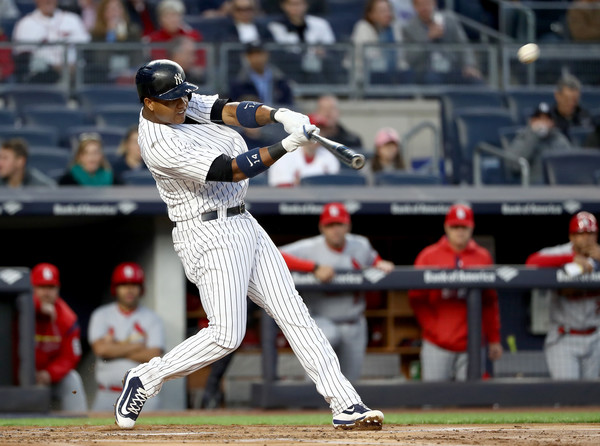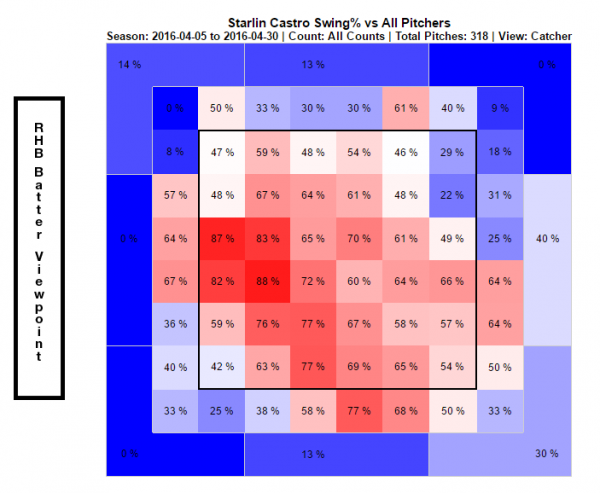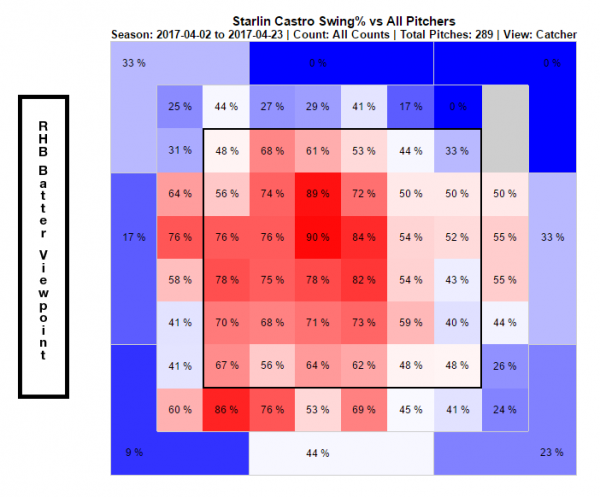
Starlin Castro is not a very good major league baseball player. This is something that precious few people would find shocking or inaccurate, and yet I feel the need to say it. His career 97 wRC+ is a bit above-average for a middle infielder, but, when combined with his subpar defense and middling to poor base-running it leads to an average of 1.8 fWAR per 150 games. If you squint, you can easily convince yourself that Castro is an average big leaguer – I just happen to take it a step further.
I was ecstatic when the Yankees dealt Adam Warren for Castro a year and a half ago. I saw a 25-year-old player that had shown flashes of greatness in his six seasons in the majors, and was just one season removed from a deserved All-Star appearance. And, given his age and overall contact-heavy approach, it wasn’t difficult to recall the 70s and 80s that scouts tossed on his hit tool back in 2010. He was a frustratingly inconsistent player, to be sure, but the talent was obvious, and he felt like the ideal ‘change of scenery’ type, given the new direction of the Cubs franchise and his status as the face of the failures of the previous several seasons.
This time last year, it seemed as though my optimistic outlook was paying off. Castro wrapped-up April batting .305/.345/.488, which was essentially his 2014 season with more power. Nothing screamed outlier, either, as his .324 BABIP was less than a handful of points higher than his career norm, his 5.7 BB% was in-line with his better seasons, as was his 12.6 K%, and his 15% HR/FB was explained by a few cheap home runs. And the power wasn’t what we were looking for anyway – it was always about Castro getting back to that .300 batting average range, and seeing what happened around it. Things were looking up.
And then he hit .244/.278/.370 for the next three months. His walk rate dropped by 1.7 percentage points, his strikeout rate jumped by nearly 8 percentage points, and his BABIP dropped down to .285. We watched Castro swing at everything between his shoulders and his ankles, and most anything that came within six inches of the strike zone. Is there hyperbole sprinkled in there? Yes, to some extent – but that’s what the Castro experience feels like. He rebounded in August and September, and that led to some positive buzz; but the damage was done.
Or so you’d think, as I’m finding myself gravitating right back into his corner.
As of this writing, Castro is batting .357/.400/.571, good for a 178 wRC+ – easily his best month in pinstripes, if not his career. It’s obviously unsustainable (note the .396 BABIP), but could we be seeing some tangible change? Maybe. Probably not … but maybe.
It all begins with his swing rates. As per FanGraphs, Castro is currently swinging at 32.5% of pitches outside of the strikezone (1.3 percentage points below his career norm), and 49.1% overall. Both are his lowest since 2014, and both are within striking distance of league-average; the aggressiveness is still there, but it has been toned down. For better or worse, however, we saw this last April, too:


Those charts are incredibly similar, and tell the same story – Castro loves to swing. And that includes swinging at pitches in on the hands, which may well be his kryptonite (announcers and fans have long lamented his propensity to be jammed inside). When everything’s working with his swing, he’ll pick up hits on those pitches; when it’s not, we see far too much weak contact.
What about the uptick in walks, though? Castro’s 6.7% walk rate would represent the high water mark of his career if it held, and it’s his best single month mark since July of 2014. That’s not great at face value, but it’s an improvement for the swing-happy second baseman. And there might just be something there, when you consider his swing percentages and his career-high 3.85 pitches per plate appearance.
That 3.85 P/PA mark is right around league-average, and represents a very real improvement from his 3.69 P/PA of 2016, and career rate of 3.68 P/PA. And that is something that we didn’t see last year, even in his hot April when he saw just 3.65 P/PA. While such a jump only represents an extra 130 or so pitches seen per season, it is nevertheless a positive indicator of a (potentially) more disciplined hitter.
There could also be something to Castro’s batted ball profile, as well. Castro is pulling the ball just 35.1% of the time, after sitting at or above 40% from 2014 through 2016. He’s also going the other way on 29.8% of batted balls, 3.8 percentage points above his career norm (and the second highest rate of his career). Given his average power, that’s a good way to take advantage of Yankee Stadium – especially when you factor in his continued uptick in flyballs and decrease in grounders.
Attempting to discern any real information from eighteen games and 75 plate appearances is something of a fool’s errand, and that oftentimes feels even more true with Starlin Castro. It is clear, though, that Castro has been a bit more disciplined this year, and that is contributing to his hot start. Moreover, prior successes (and scouting reports) tell us that the talent is there, and many of us have bought in, albeit to varying degrees. When talent and production meet in an age-27 season, the word ‘breakout’ comes to mind – but we’ve been fooled before.
Leave a Reply
You must be logged in to post a comment.